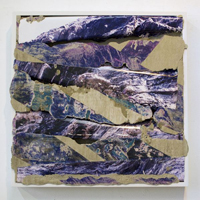Many of the artists in this expansive exhibition place an emphasis on the physicality—or lack thereof—of photography rather than on its capacity to represent the outside world. As a whole, “What Is a Photograph?” might be taken as a diagnostic inquiry, with the title reading as a rhetorical question. Curated by Carol Squiers, the exhibition includes twenty-one artists, ranging from Gerhard Richter and James Welling to Liz Deschenes and Eileen Quinlan, and has tasked itself with surveying the medium since the 1970s.
The work of both Matthew Brandt and Letha Wilson exhume a long-standing tradition of American landscape photography with fresh invigoration. In Brandt’s large-scale Grays Lake, ID 7, 2013, Technicolor abstractions stem from an actual processing bath in the depicted lake waters, while Wilson’s monolith Grand Tetons Concrete Column, 2012, employs industrial concrete to sculpturally engage her iconic views of the American West. Draped through the gallery’s foyer is Mariah Robertson’s 154, 2010. This single photograph measures one hundred feet in length and has been meticulously hand-processed by the artist in a highly toxic photochemical environment. The remarkable result validates its production, as every inch of this dangling photograph reveals a labyrinth of glowing hues and pictorial intricacies.
Parallel to romanticizing the darkroom are the several artists who wholeheartedly embrace the more conventional, digitalized avenues associated with the medium. Travess Smalley’s Capture Physical Presence #15, 2011, exploits the imaging systems of a flatbed scanner to manipulate his collages into what he describes as mind-numbing “feedback loops.” Kate Steciw’s approach in Apply, 2012, takes advantage of a Google-based research method, purchased stock imagery, and sculptural tack-ons that recall the slick advertisements of commercial photography. Elsewhere in the gallery, a wall text accompanying Jon Rafman’s eerie and unadorned busts reads, “The age demanded an image / Of its accelerated grimace, Something for the modern stage / Not, at any rate, an attic grace.”

